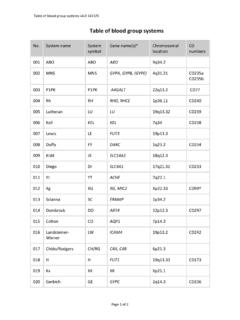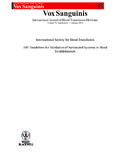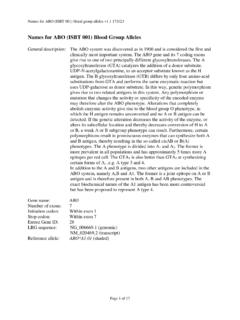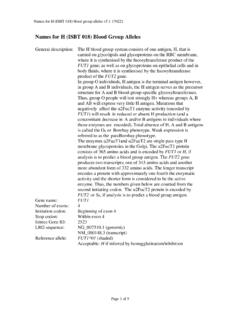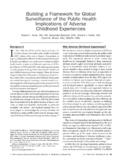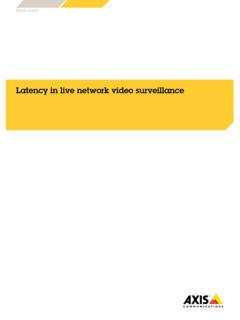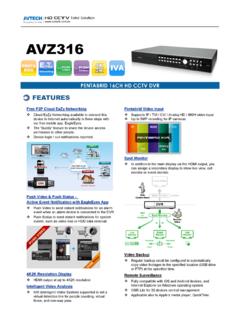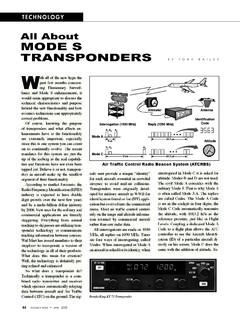Transcription of WORKING PARTY ON HAEMOVIGILANCE
1 PROPOSED STANDARD DEFINITIONS FOR surveillance OF NON INFECTIOUS ADVERSE TRANSFUSION REACTIONS JULY 2011 Incorporating correction to TRALI definition (as adopted June 2013) WORKING PARTY ON HAEMOVIGILANCE INTRODUCTION The definitions proposed in this document were prepared by a sub-group of members of the ISBT WORKING PARTY on HAEMOVIGILANCE comprising: Dr Mark Popovsky, USA Dr Pierre Robillard, Canada Dr Martin Schipperus, Netherlands Dr Dorothy Stainsby, United Kingdom Dr Jean-Daniel Tissot, Switzerland Dr Johanna Wiersum-Osselton, Netherlands. The definitions were inspired from a document written by Dr Juergen Bux on proposed definitions by the European HAEMOVIGILANCE Network, from existing definitions in various HAEMOVIGILANCE systems and from published literature.
2 The definitions were reviewed and adopted by the ISBT WORKING PARTY on HAEMOVIGILANCE at its meeting in Capetown on September 2, 2006. Case scenarios from actual HAEMOVIGILANCE reports were developed and volunteers from various HAEMOVIGILANCE systems agreed to classify the cases using the standard definitions. Good agreement was obtained for the case definitions but a less good agreement was obtained for imputability grading. It was decided to keep imputability grading as developed because already in use in multiple HAEMOVIGILANCE systems. These definitions are for the sole purpose of surveillance of adverse events related to the transfusion of blood components in HAEMOVIGILANCE systems.
3 They are not intended as strict diagnostic criteria. Standard definitions are essential if comparisons from different HAEMOVIGILANCE systems are to be made. The purpose of this document is to provide such standard definitions that need to be simple yet precise enough to be able to classify most adverse transfusion events. We first propose general definitions of adverse transfusion events, near misses, incidents and reactions. The non infectious reactions are then addressed with hemolytic and non hemolytic reactions followed by a proposed classification of severity and imputability (strength of association with transfusion) of adverse events.
4 This document does not provide categories and definitions for types of transfusion errors and near misses. The proposed definitions of adverse reactions apply to the adult population of patients. Adaptations of the definitions will have to be made by institutions for the pediatric patient population and especially for neonates. We hope this document will help the various HAEMOVIGILANCE systems to classify the adverse reactions reported to them in order to generate data that will be comparable at an international level. Pierre Robillard, MD Chair, ISBT WORKING PARTY on HAEMOVIGILANCE 1 GENERAL DEFINITIONS OF ADVERSE EVENTS An adverse event is an undesirable and unintended occurrence before, during or after transfusion of blood or blood component which may be related to the administration of the blood or component.
5 It may be the result of an error or an incident and it may or not result in a reaction in a recipient. An incident is a case where the patient is transfused with a blood component which did not meet all the requirements for a suitable transfusion for that patient, or that was intended for another patient. It thus comprises transfusion errors and deviations from standard operating procedures or hospital policies that have lead to mistransfusions. It may or may not lead to an adverse reaction. A near miss is an error or deviation from standard procedures or policies that is discovered before the start of the transfusion and that could have led to a wrongful transfusion or to a reaction in a recipient.
6 An adverse reaction is an undesirable response or effect in a patient temporally associated with the administration of blood or blood component. It may, but need not, be the result of an incident. 2 HEMOLYTIC TRANSFUSION REACTIONS A hemolytic transfusion reaction is one in which symptoms and clinical or laboratory signs of increased red cell destruction are produced by transfusion. Hemolysis can occur intravascularly or extravascularly and can be immediate (acute) or delayed. Acute hemolytic transfusion reaction (AHTR) An AHTR has its onset within 24 hours of a transfusion. Clinical or laboratory features of hemolysis are present. Common signs of AHTR are: Fever Chills/rigors Facial flushing Chest pain Abdominal pain Back/flank pain Nausea/vomiting Diarrhea Hypotension Pallor Jaundice Oligoanuria Diffuse bleeding Dark urine Common laboratory features are: Hemoglobinemia Hemoglobinuria Decreased serum haptoglobin Unconjugated hyperbilirubinemia Increased LDH an AST levels Decreased hemoglobin levels Not all clinical or laboratory features are present in cases of AHTR.
7 Blood group serology usually shows abnormal results but absence of immunological findings does not exclude AHTR. AHTR may also be due to erythrocyte auto-antibodies in the recipient or to non immunological factors like mechanical factors inducing hemolysis (malfunction of a pump, of a blood warmer, use of hypotonic solutions, etc.). Delayed hemolytic transfusion reaction (DHTR) A DHTR usually manifests between 24 hours and 28 days after a transfusion and clinical or laboratory features of hemolysis are present. Signs and symptoms are similar to AHTR but are usually less severe. DHTR may sometimes manifests as an inadequate rise of post-transfusion hemoglobin level or unexplained fall in hemoglobin after a transfusion.
8 Blood group serology usually shows abnormal results. Delayed serologic reaction (DSTR) There is a DSTR when, after a transfusion, there is demonstration of clinically significant antibodies against red blood cells which were previously absent (as far as is known) and when there are no clinical or laboratory features of hemolysis. This term is synonymous with alloimmunization. 3 NON HEMOLYTIC TRANSFUSION REACTIONS Febrile non hemolytic transfusion reaction (FNHTR) There is a FNHTR in the presence of one or more of: fever ( 38oC oral or equivalent and a change of 1oC from pretransfusion value), chills/rigors This may be accompanied by headache and nausea.
9 Occurring during or within four hours following transfusion without any other cause such as hemolytic transfusion reaction, bacterial contamination or underlying condition. FNHTR could be present in absence of fever (if chills or rigors without fever). FOR THE PURPOSE OF INTERNATIONAL COMPARISONS ONLY THE MOST SERIOUS CASES OF FNHTR SHOULD BE ACCOUNTED FOR: fever ( 39oC oral or equivalent and a change of 2oC from pretransfusion value) and chills/rigors Allergic reaction An allergic reaction may present only with mucocutaneous signs and symptoms: Morbilliform rash with pruritus Urticaria (hives) Localized angioedema Edema of lips, tongue and uvula Periorbital pruritus, erythema and edema Conjunctival edema occurring during or within 4 hours of transfusion.
10 In this form it usually presents no immediate risk to life of patient and responds quickly to symptomatic treatment like anti-histamine or steroid medications. This type of allergic reaction is called minor allergic reaction in many hemovigilance systems. For the purpose of classification this type of allergic reaction would be graded as 1, non-severe. An allergic reaction can also involve respiratory and/or cardiovascular systems and present like an anaphylactic reaction. There is anaphylaxis when, in addition to mucocutaneous systems there is airway compromise or severe hypotension requiring vasopressor treatment (or associated symptoms like hypotonia, syncope).


